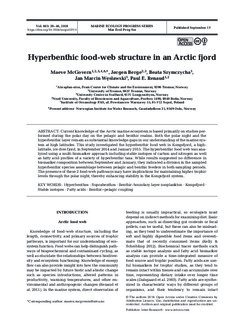| dc.contributor.author | McGovern, Maeve | |
| dc.contributor.author | Berge, Jørgen | |
| dc.contributor.author | Szymczycha, Beata | |
| dc.contributor.author | Weslawski, Jan Marcin | |
| dc.contributor.author | Renaud, Paul Eric | |
| dc.date.accessioned | 2018-11-15T13:40:55Z | |
| dc.date.available | 2018-11-15T13:40:55Z | |
| dc.date.created | 2018-10-05T13:24:04Z | |
| dc.date.issued | 2018 | |
| dc.identifier.citation | McGovern, M., Berge, J., Szymczycha, B., Weslawski, J. M., Renaud, P. E. (2018). Hyperbenthic food-web structure in an Arctic fjord. Marine Ecology Progress Series, 603, 29-46. doi: | nb_NO |
| dc.identifier.issn | 1616-1599 | |
| dc.identifier.uri | http://hdl.handle.net/11250/2573067 | |
| dc.description.abstract | Current knowledge of the Arctic marine ecosystem is based primarily on studies performed during the polar day on the pelagic and benthic realms. Both the polar night and the hyperbenthic layer remain as substantial knowledge gaps in our understanding of the marine system at high latitudes. This study investigated the hyperbenthic food web in Kongsfjord, a high-latitude, ice-free fjord, in September 2014 and January 2015. The hyperbenthic food web was analyzed using a multi-biomarker approach including stable isotopes of carbon and nitrogen as well as fatty acid profiles of a variety of hyperbenthic taxa. While results suggested no difference in biomarker composition between September and January, they indicated a division in the sampled hyperbenthic species assemblage between pelagic and benthic feeders in both sampling periods. The presence of these 2 food-web pathways may have implications for maintaining higher trophic levels through the polar night, thereby enhancing stability in the Kongsfjord system. | nb_NO |
| dc.language.iso | eng | nb_NO |
| dc.publisher | Inter Research | nb_NO |
| dc.rights | Navngivelse 4.0 Internasjonal | * |
| dc.rights.uri | http://creativecommons.org/licenses/by/4.0/deed.no | * |
| dc.title | Hyperbenthic food-web structure in an Arctic fjord | nb_NO |
| dc.type | Journal article | nb_NO |
| dc.type | Peer reviewed | nb_NO |
| dc.description.version | publishedVersion | nb_NO |
| dc.rights.holder | © 2018, The Author(s) | nb_NO |
| dc.subject.nsi | VDP::Matematikk og Naturvitenskap: 400::Zoologiske og botaniske fag: 480::Marinbiologi: 497 | nb_NO |
| dc.subject.nsi | VDP::Matematikk og Naturvitenskap: 400::Zoologiske og botaniske fag: 480::Økologi: 488 | nb_NO |
| dc.source.pagenumber | 29-46 | nb_NO |
| dc.source.volume | 603 | nb_NO |
| dc.source.journal | Marine Ecology Progress Series | nb_NO |
| dc.identifier.doi | 10.3354/meps12713 | |
| dc.identifier.cristin | 1618216 | |
| dc.relation.project | UK Natural Environment Research Council: Oceans 2025 | nb_NO |
| dc.relation.project | Norsk forskningsråd: 214271/F20 | nb_NO |
| dc.relation.project | Norsk forskningsråd: 216537 | nb_NO |
| dc.relation.project | Norsk forskningsråd: 226417 | nb_NO |
| dc.description.localcode | Paid Open Access | |

